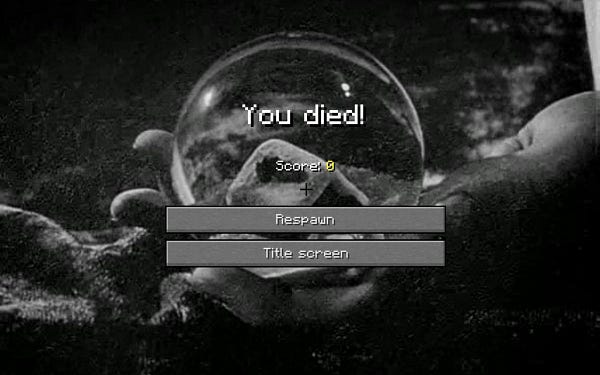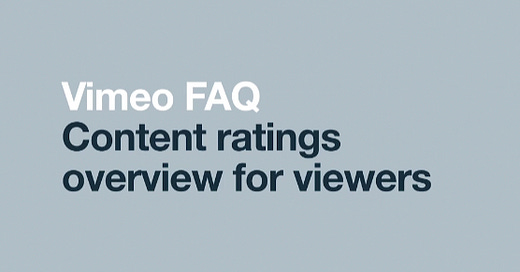I had originally planned to dedicate this issue to the news of David Fincher’s upcoming series of “visual essays” for Netflix. There is much to consider. And in the months ahead, once we learn more about the series and perhaps after it is released, I think it would be great to have some sort of roundtable with videographic critics on the podcast. You can read more about the announcement via David Hudson over at Criterion. (Many thanks for the shoutout, David!)
But I want to put my thoughts on that to the side for now and share an important tip. Thanks to recent posts by Ian Garwood and Barbara Zecchi, many of us have learned about certain restrictions placed on Vimeo videos that do not adhere to certain settings. The policy reads:
Furthermore, in order to remain compliant with laws and regulations around the world, we have to make sure that children are not able to access mature content posted on Vimeo's platform and content that contains advertisements. As such, we strongly encourage you to select a content rating for all of your videos, especially Public videos. Failure to do so may lead to viewers in certain countries not being able to see your Public videos without first logging into Vimeo.
So, for example:
If you are located in the United Kingdom or European Union and are not logged into a Vimeo account, you will be prompted to log in to watch an unrated video or a video rated “Mature” on vimeo.com.
What this means is that if you have not gone in and rated your videos on Vimeo, many users may not be able to access them, or at least not easily access them. It’s easy to imagine how many people do not have a Vimeo account of their own, or at least are not logged in regularly unless they are uploading work of their own. Vimeo is not like Facebook or Twitter in that users need to have an account to access most content. And it’s of course unlike YouTube in that it is not linked to a more general service like Google Workspace. One can be on Vimeo and not even realize that certain videos are unavailable to them.
So, here’s what you should do. The easiest option is probably to adjust the content ratings of your videos in bulk. Luckily, Vimeo allows you to do this very easily and in literally a few seconds. You can follow the instructions via the same link above.
Or, you can instead manually adjust the content rating of each individual video. This can be done by going to your video, selecting “Advanced Settings,” then going to “General” and “Privacy.” That’s it!
Once again, thank you to Barbara and Ian for sharing this information. If you have any other tips related to making sure one’s Vimeo videos are more accessible to all, please feel free to get in touch! I’ll share the information here. You can reach me at willdigravio@gmail.com.
Support the Show on Patreon
Please consider supporting this newsletter, the podcasts, and the other work I do on Patreon! Subscribers now get exclusive access to “video essay guides” to certain topics every other Monday. The most recent guide is “The Supercut: A Videographic Introduction.” Learn more and support the show here.
The latest guide will be posted tomorrow!
Preview to Episode 29. Thomas Flight
The next episode of The Video Essay Podcast will feature a conversation with Thomas Flight. On the show, Thomas and I discuss a wide range of topics, including two videos in great detail: “The Side of Scorsese We Don’t Talk About” and Jacob Geller’s “The Game That Won’t Let You See All of It.” Watch both below.
News & Notes
Please send news and notes for future newsletters to willdigravio@gmail.com
October
The Essay Library has put out a call for participants in another collaborative project. You may have seen their "Essay Library Anthologies" in the past, where video essayists from across the Internet came together to create sixty-second micro-essays inspired by the themes of beginnings and time. The theme for this third volume is “Death.” The deadline is October 27. Learn more here.


November
The True/False Film Festival is now accepting submissions. The regular deadline is November 1. More here.
Video essayist and scholar Alan O’Leary will hold an online book launch event and discussion for his work, The Battle of Algiers, on November 5. Register here.
Kevin B. Lee shared a call for applications for a Post-Doc position now open for the Locarno Film Festival Future of Cinema and Audiovisual Arts program at Università della Svizzera italiana. The deadline is November 30. More here.
December
The “New Creative Praxis in Film & TV: Hybrid Futures of Gender Equality” online conference at Istanbul Bilgi University is now accepting submissions, and is especially interested in video essays and practice research. The deadline is December 1. More here. (h/t Katie Bird)
More Notes (New)
Johannes Binotto has made available lectures and videos from a recent video essay workshop at Charles University entitled, “Minor Instances, Major Consequences.” Watch and read here.
Steve Macfarlane has assembled a great Twitter thread of various film catalogues in PDF form from the 70s, 80s, and 90s. You can find the thread here. (h/t Catherine Grant)
Zia Anger has started performing My First Film live and in person again. Follow Zia on Twitter for more information about shows.
Adrian Martin and Cristina Álvarez López have released the second episode of their “Multimedia Lectures On Film” series. This one centers on La Captive (Chantal Akerman, 2000). Watch here.
I may have shared links to these resources before, but Ariel Avissar recently shared them again so here they are again! Ian Garwood put together collections of discussions and videos on videographic criticism. Here is a collection of videos on YouTube. And another for videos on Vimeo.
And finally, again, the big Fincher news:
More Notes (Cont.)
A video essay by Queline Meadows on Wolfwalkers will be included in an upcoming Blu-ray box set! Learn more here.
A trailer for Philip Brubaker’s upcoming essay film, How to Explain Your Mental Illness to Stanley Kubrick. Watch here.
“Thinking through the Video Essay” - a presentation by Catherine Grant at the TECMERIN video essay conference is now available online. Watch here.
Catherine Grant’s slides from a recent public lecture on the epigraphic video essay are now available on her website. Access here.
A great new video by Ariel Avissar, “How to Make A Videographic Epigraph?” Watch here.
I’ve discovered many new films and readings through Tanya Goldman’s open access syllabus for a class on experimental documentary at Sarah Lawrence College. Read here.
Follow “A Girl's Eye-view: Girlhood on the Italian Screen since 1950”, a new project by Prof. Danielle Hipkins (University of Exeter) and Prof. Romana Andò (Sapienza Uni di Roma), on Twitter here, and on Facebook here.
Art & Trash is a source for video essays on underground, avant-garde, psychotronic and outsider media from Stephen Broomer. Subscribe to the new newsletter here.
And finally, Screenworks is currently accepting submissions for Volume 12.1. Here’s a video celebrating all of the submissions (including several video essays) that were published as part of Volume 11.1!




